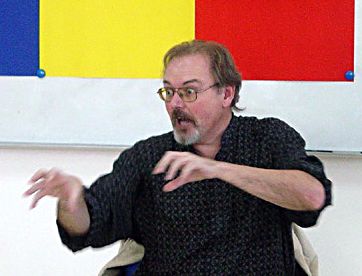At 113 years old, Miss Treason, a witch, knows about the connection between age, beans, fresh fruit and 'letting out wind'!
Tiffany, only 13 years old, with a 'he's not my boyfriend!' (even if he does send her letters with SWALK on them), is learning witchcraft from Miss Treason. She discovers there is lot of hard work, cleaning around the cobwebs and polishing the skulls, chasing after the cheese - called Horace, a rather single-minded blue cheese - oh, and a strange tingling feeling behind the eyes when Miss Treason, who is blind, uses you as a mirror.
Like most teenage girls, Tiffany has a will of her own - and even if she was told to stay still and just watch, why can't she join in the dance - especially when there is an empty space just waiting for her?
Months latter, with the snow falling thick, burying the newborn lambs, with a young brother missing and with her father begging her to help, she understands why.
This is one of Terry Pratchett's books for 'all children, aged 12 and above' - meaning anyone who is or once was 12!
It has a thumping good story line - strong characters, awful jokes and moments of danger: Perfect for the Christmas stocking.
At the heart of it is Tiffany's growing sense of identity - she has to cope with establishing who she is in a world of strong personalities (none stronger than Granny Weatherwax - control freak leader of the witches - who don't have a leader), deal with Death - and loss (someone has to clean up after the funeral, and milk the goat, and hide the Boffo), and ward off the unwanted attentions of a love-struck adolescent elemental.
This might be Discworld - but the emotions and themes are of this world.
The clear lines of the plot, the straightforward language and the characters all make this an attractive read for younger teenagers - but straight forward doesn't mean without depth.
As with many of his other books, Pratchett taps into age-old myths - fictional expressions of the fears and hopes, the irrational explanations of what it is to be human.
Here we have the Persephony myth entangled with Morris Dancing; Orpheus and the 'Wee People' working together; Celtic Ironsmiths crossed with the Greek pantheon.
This gives the story much greater significance - it is for the proto-adult in the child as much as for the vestigial child in the adult.
Yes, I smile when I see Morris Dancers prancing around in the concrete shopping centres of our towns - but having read this book, I will now see a dance which touches on the very turning of the seasons.
It is a Carry On meets The Golden Bough sort of experience!

No comments:
Post a Comment